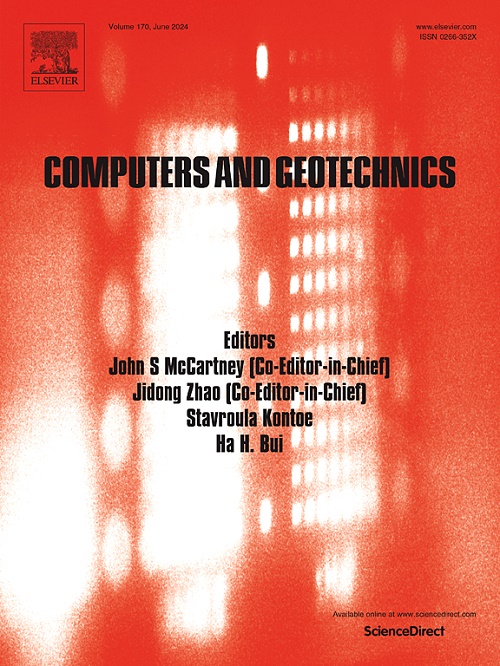集料-橡胶混合物的复杂网络和织物驱动非仿射运动学
IF 6.2
1区 工程技术
Q1 COMPUTER SCIENCE, INTERDISCIPLINARY APPLICATIONS
引用次数: 0
摘要
在剪切过程中,聚集体-橡胶(AR)混合物的系综行为主要受颗粒级重排及其相互作用的影响,尤其是橡胶颗粒的变形。本研究提出了一个将中观尺度网络拓扑与宏观力学行为联系起来的定量框架,强调橡胶颗粒对应变局部化和力链形成的稳定影响。本研究使用耦合离散元自由伽辽金法(DEM-EFG)进行二维数值模拟,以准确模拟颗粒组合中单个橡胶颗粒的变形。对不同橡胶含量比例的AR混合物进行简单剪切,研究大应变下的非仿射运动学。构建复杂网络图来表示粒子中心及其与邻近粒子的连接,从而可以分析加权和未加权的强子网络。网络指标表明,橡胶颗粒的加入增加了三角形基元的密度,并限制了更大循环成员的形成,从而减少了滑动接触和颗粒旋转。采用基于替代网络的动能测量方法分析了力链的崩溃动力学,捕获了加入橡胶颗粒后应变局部化的时间渗透减少。本研究的一个关键发现是AR细观结构中小尺寸循环的缓慢破坏,以及AR接触的弱织物各向异性。这是由于高橡胶含量AR混合物中偶联应力的减小和非仿射位移空间相关性的快速衰减。本文章由计算机程序翻译,如有差异,请以英文原文为准。
Complex network and fabric driven non-affine kinematics of aggregate-rubber mixtures
The ensemble behavior of aggregate-rubber (AR) mixtures during shear is governed by the particle level rearrangements and their interaction especially due to rubber particle deformation. This study presents a quantitative framework that connects meso-scale network topology to macroscopic mechanical behavior, emphasizing the stabilizing influence offered by rubber particles on strain localization and the formation of force chains. This study conducts 2D numerical simulations with a coupled Discrete-Element Free Galerkin Method (DEM-EFG) to accurately model the deformation of individual rubber particles within granular assemblies. AR mixtures with different proportions of rubber content are subjected to simple shear to investigate non-affine kinematics at large strains. Complex network graphs are constructed to represent particle centers and their connections with neighboring particles, enabling the analysis of weighted and unweighted strong sub-networks. The network metrics reveal that the addition of rubber particles increases the density of triangular motifs and restricts the formation of larger cycle memberships, thereby reducing sliding contacts and particle rotation. The collapse dynamics of force chains are analyzed using surrogate network-based measures of kinetic energy, capturing the reduced temporal percolation of strain localization with addition of rubber particles. A key finding of this study is the slow destruction of small-sized cycles in the AR meso-structures, along with weak fabric anisotropy of AR contacts. This behavior is attributed to the reduced couple stress and the rapid decay of spatial correlation in non-affine displacement within AR mixtures with high rubber content.
求助全文
通过发布文献求助,成功后即可免费获取论文全文。
去求助
来源期刊

Computers and Geotechnics
地学-地球科学综合
CiteScore
9.10
自引率
15.10%
发文量
438
审稿时长
45 days
期刊介绍:
The use of computers is firmly established in geotechnical engineering and continues to grow rapidly in both engineering practice and academe. The development of advanced numerical techniques and constitutive modeling, in conjunction with rapid developments in computer hardware, enables problems to be tackled that were unthinkable even a few years ago. Computers and Geotechnics provides an up-to-date reference for engineers and researchers engaged in computer aided analysis and research in geotechnical engineering. The journal is intended for an expeditious dissemination of advanced computer applications across a broad range of geotechnical topics. Contributions on advances in numerical algorithms, computer implementation of new constitutive models and probabilistic methods are especially encouraged.
 求助内容:
求助内容: 应助结果提醒方式:
应助结果提醒方式:


